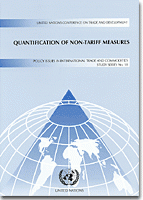
This paper is concerned with the measurement of non-tariff measures (NTMs) for use in the formulation of trade policy. First, NTMs are defined and classified. Second, welook at the effects of NTMs and how to compute those effects. This includes a review of the inventory approach, under which NTMs are catalogued, modelling approaches, tariff equivalents, subsidy equivalents, the Trade Restrictiveness Index (TRI) and effective protection. Third, there is a brief discussion on sources of data on NTMs, which is followed by some results on the landscape of NTMs in the Asia-Pacific region. The paper concludes with a discussion on how to proceed with the issue of enhancing the collection and measurement of NTM data.
This is a brief introduction to the subject and is not meant to be a comprehensiveliterature survey; however, the reference list should be of assistance to those who wish to delve further into the science (or art!) of commercial policy measurement. To steer readers, the most useful starting place would be Baldwin (1970a) and Corden (1971). Other useful studies are Laird and Yeats (1990), Feenstra (1988a), Vousden (1990) and Helpman and Krugman (1989). Agriculture has an NTM measurement industry of its own: starting places are Krueger, Schiff and Valdes (1988), Goldin and Knudsen (1990), OECD (1994), and Webb, Lopez and Penn (1990). A new body of literature, in the nascent stage, concerns the Trade Restrictiveness Index, developed by Anderson and Neary (1994a), mainly designed to measure changes in welfare resulting from policy changes over time.


